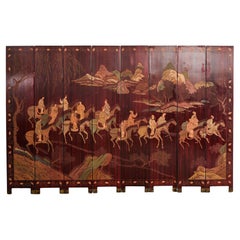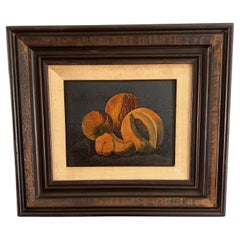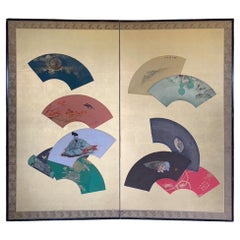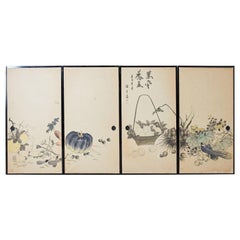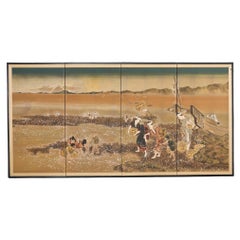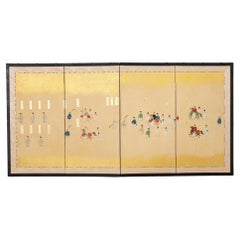Hand-Crafted Paintings and Screens
to
17
138
18
202
27
2
7
5
4
3
1
14
49
139
29
33
34
14
1
6
1
5
12
7
2
1
159
116
106
105
97
207
198
157
38
11
231
225
226
27
1
1
1
1
Technique: Hand-Crafted
Chinese Export Eight Panel Coromandel Screen Horse Riding
Located in Rio Vista, CA
Remarkable Chinese export eight-panel coromandel screen featuring a country landscape with men on horseback. The panels have a faded lacquer patina in a rich oxblood or cordovan tone...
Category
20th Century Chinese Chinese Export Hand-Crafted Paintings and Screens
Materials
Brass
Vintage Painting Still Life with Fruit - Study of Mellons
Located in San Diego, CA
The oil on canvas painting majestically depicts a group of mellons in different sizes. The scene is depicted against a dark ground, however the artist has included dimension by focus...
Category
1950s American British Colonial Vintage Hand-Crafted Paintings and Screens
Materials
Wood, Paint, Canvas
Taisho Golden Fan Screen
Located in Fukuoka, JP
Taisho Golden Fan Screen
Period: Meiji
Size: 190x171 cm
SKU: PTA111
Step into a world of elegance with our exquisite two-panel Taisho screen adorned in gold, depicting fans adorned...
Category
20th Century Japanese Taisho Hand-Crafted Paintings and Screens
Materials
Gold Leaf
$4,570
Set of Four Japanese Fusuma Painted Door Panels
Located in Rio Vista, CA
Rare set of four Japanese Showa period door panels known as Fusuma in Japanese architecture. Similar to a Shoji room divider but made of an opaque materia...
Category
20th Century Japanese Showa Hand-Crafted Paintings and Screens
Materials
Brass
$2,400 Sale Price / set
20% Off
Japanese Showa Screen Shell Gathering After Katsushika Hokusai
Located in Rio Vista, CA
Fascinating Japanese Showa period four-panel byobu screen depicting women shell gathering or clamming after the painting by Katsushika Hokusai (Japanese 1760-1849). The women are gat...
Category
20th Century Japanese Showa Hand-Crafted Paintings and Screens
Materials
Brass
Japanese Showa Four Panel Table Screen Noble Procession
Located in Rio Vista, CA
Fascinating Japanese Showa period for panel table screen depicting a procession of guards, nobles and attendants. Vibrant ink and color natural pigments on mulberry paper with gold f...
Category
20th Century Japanese Showa Hand-Crafted Paintings and Screens
Materials
Brass
Japanese Showa Two Panel Screen Embroidered Silk Gilt Boxes
Located in Rio Vista, CA
Charming Japanese Showa period two-panel folding byobu screen featuring an embroidered silk picture of beautiful gift boxes. Stunning pattern of Hanaguruma (flower cart) laden with d...
Category
20th Century Japanese Mid-Century Modern Hand-Crafted Paintings and Screens
Materials
Silk, Wood, Paper
Japanese Style Two-Panel Screen Winter Goose in Flight
Located in Rio Vista, CA
Dramatic Showa period two panel folding byobu screen depicting a large white goose in flight in an evening snow covered winter landscape. Made in the American school style watercolor...
Category
20th Century Showa Hand-Crafted Paintings and Screens
Materials
Brass
Japanese Asian Signed Four-Panel Folding Byobu Showa Screen Lady Murasaki Genji
Located in Studio City, CA
A gorgeous and quite striking four-panel Japanese Byobu folding screen featuring an elegantly clad Lady Murasaki, the Japanese novelist, (and famed author of the classic "Tale of Gen...
Category
Mid-20th Century Japanese Showa Hand-Crafted Paintings and Screens
Materials
Gold Leaf
Vintage kimono textile art "Snowflake ~New Beginnings~" by ikasu Purple, Japan
By Kimono ikasu
Located in Setagaya City, JP
Six canvases (Diameter approx. 30cm, 25cm, 20cm) use the fabric taken from antique kimono, its' various parts, to create one harmonious fluid image of a snowflake - a symbol of new b...
Category
1970s Japanese Japonisme Vintage Hand-Crafted Paintings and Screens
Materials
Canvas, Silk
Chinese Export Soapstone Folding Screen Room Divider
Located in West Sussex, Pulborough
We are delighted to offer for sale this extremely well-made and highly collectable Chinese Export Soapstone room divider folding screen depicting court beauties
A truly stunning and...
Category
20th Century Chinese Chinese Export Hand-Crafted Paintings and Screens
Materials
Soapstone
Four Antique 19th Century circa 1880 Chinese Gouaches on Rice Paper Geisha Girls
Located in West Sussex, Pulborough
We are delighted to offer for sale this lovely suite of four antique circa 1880’s Chinese hand painted Gouache paintings depicting Geisha girls in traditional settings.
A very good looking and beautifully painted suite, they were made for the export market during the British colonialism...
Category
1880s Chinese Chinese Export Antique Hand-Crafted Paintings and Screens
Materials
Paper
Pair of Japanese Taisho Period Screens Paragons of Filial Piety
Located in Rio Vista, CA
Impressive pair of Japanese screens from the Taisho period meiji. Each six-panel screen depicts an image from the 24 paragons of filial piety ...
Category
20th Century Japanese Taisho Hand-Crafted Paintings and Screens
Materials
Brass, Gold Leaf
Japanese Edo Period Six Panel Screen of Chinese Scholars
Located in Rio Vista, CA
Fascinating 19th century Japanese late Edo period six pane funpon screen. Large scale depicting Chinese scholars and officials engaged in leis...
Category
19th Century Japanese Edo Antique Hand-Crafted Paintings and Screens
Materials
Silk, Wood, Paper
Pair of Chinese Reverse Glass Paintings, Early 20th Century
Located in Jimbaran, Bali
This pair of Chinese portraits depicting young women & their dogs were painted using a reverse glass painting technique. Painting in reverse on the opposite side of a piece of glass ...
Category
Early 20th Century Chinese Qing Hand-Crafted Paintings and Screens
Materials
Glass, Wood, Paint
$756 Sale Price / set
20% Off
Pair Mid Century Japanese Framed Signed Oshie Art C.1950
Located in London, GB
Pair Mid Century Japanese Framed Signed Oshie Relief Art C.1950
Oshie decorative art meaning “pressed pictures” that goes back to the Edo Period (1603-1868) consisting of paper and ...
Category
Mid-20th Century Japanese Hand-Crafted Paintings and Screens
Materials
Textile, Acrylic, Paper
Japanese Edo Two Panel Screen Children Playing Catching Fish
Located in Rio Vista, CA
Delightful late 18th century/early 19th century Japanese Edo period two panel byobu screen depicting children at play near a riverbank and catching fish. Painted in the Maruyama-Shij...
Category
18th Century Japanese Edo Antique Hand-Crafted Paintings and Screens
Materials
Silk, Wood, Paper
Set of 4 Modernist Original Art Portraits 1950s
Located in San Diego, CA
Incredible set of 4 original art portraits from the 1950s. These original pieces are signed and unique in their style. The use of strong, unblended colors and a somewhat flattened ...
Category
1950s American Mid-Century Modern Vintage Hand-Crafted Paintings and Screens
Materials
Paint
$1,150 / set
Antique obi textile art " Pine forest ~ Longivety ~ " by ikasu Green , Japan
By Kimono ikasu
Located in Setagaya City, JP
<< Story behind the work >>
Obi fabric I used for this artwork is taken from three different over 100-years-old antique sashes, and is framed in wood taken from antique chest-of-dra...
Category
Early 20th Century Japanese Japonisme Hand-Crafted Paintings and Screens
Materials
Gold Leaf
Antique kimono textile art " Kobachi ~Marine Collection~ " by ikasu Blue, Japan
By Kimono ikasu
Located in Setagaya City, JP
This work is inspired by the blue color palette, and is framed in paulownia wood originally used for a kimono chest-of-drawers.
In this artwork, the aim was to capture the wide pale...
Category
1920s Japanese Japonisme Vintage Hand-Crafted Paintings and Screens
Materials
Silk, Wood
Chinoiserie Palm Oval Paintings
Located in Sturminster Marshall, Dorset
A pair of carved giltwood Chippendale crossed palm frames, with inset hand-painted chinoiserie portraits of 18th century oriental nobility.
We a...
Category
21st Century and Contemporary English Chippendale Hand-Crafted Paintings and Screens
Materials
Gold Leaf
$6,596 / set
Japanese Contemporary Silk Red Black Cream Hand-Crafted Two Panel Folding Screen
Located in Takarazuka, JP
Exceptional Japanese contemporary two panel "byobu" or folding screen featuring genryoku style handcrafted silk raised kimono Japanese decorative art in crimson red, cream and gold o...
Category
21st Century and Contemporary Japanese Meiji Hand-Crafted Paintings and Screens
Materials
Gold
Edo Period Rimpa School Golden Screen - Summer Florals
By Rimpa School
Located in Fukuoka, JP
Edo Period Golden Screen - Summer Florals
Period: Edo
Size: 285 x 92.5 cm (112.2 x 36.4 inches)
SKU: PTA141
This Edo period screen is a golden-framed window into the summer gardens...
Category
18th Century Japanese Edo Antique Hand-Crafted Paintings and Screens
Materials
Gold Leaf
Pair of Japanese Screens
Located in Schellebelle, BE
Exceptional pair of Japanese screens, 20th century
Six parts, six times 45 cm wide
Gold spotted paper with parts of old screens.
Category
Mid-20th Century Japanese Hand-Crafted Paintings and Screens
Materials
Paper
$6,526 / set
Vintage kimono textile art "On Coral Waves ~Everlasting~" by ikasu Pink, Japan
By Kimono ikasu
Located in Setagaya City, JP
<< About this canvas >>
This kimono canvas set of three pieces portrays mountains surrounded by the sea. While each of the three pieces is crafted from different kimonos, they all s...
Category
1970s Japanese Japonisme Vintage Hand-Crafted Paintings and Screens
Materials
Silk, Canvas
Pair of Stunning Vintage Soapstone & Mother of Pearl Geisha Girl Wall Panels
Located in West Sussex, Pulborough
We are is delighted to offer for sale this stunning pair of vintage circa 1940s Chinese chinoiserie wall plaques depicting Geisha girls in soa...
Category
1940s Chinese Chinoiserie Vintage Hand-Crafted Paintings and Screens
Materials
Soapstone
Antique kimono textile art " Plum Blossom Night ~Resilience~ " by ikasu Japan
By Kimono ikasu
Located in Setagaya City, JP
This artwork uses antique fabric from Taisho era (early 1920ies) kimono and paulownia wood taken from antique kiritansu - chest-of-drawers used initially to keep kimonos.
It is eleg...
Category
1920s Japanese Japonisme Vintage Hand-Crafted Paintings and Screens
Materials
Silver Leaf
Vintage obi textile art " Moon phase II " by ikasu Silver, Black, Japan
By Kimono ikasu
Located in Setagaya City, JP
<< About this artwork >>
This artwork has been upcycled from a stunning obi, which is adorned with calligraphy weaving saying "moon" and "moonlight".
<< Period / Story >>
The obi...
Category
1970s Japanese Japonisme Vintage Hand-Crafted Paintings and Screens
Materials
Silver Leaf
Antique kimono textile art "Prosperity Tree" by ikasu Black, Japan
By Kimono ikasu
Located in Setagaya City, JP
This work uses an antique kimono fabric dated Taisho era (early 1910th), with a pine tree motif, and arranges it so that it looks like a tree decorated with various auspicious symbols - persimmons, pines, peonies, etc.
The line in the middle symbolizes “kintsugi” - concept of wabi-sabi, which values imperfection, impermanence, and the beauty of aging.
It is elegantly framed with paulownia wood originally used for kimono chest-of-drawers, and is filled with storytelling and sense of luxury.
I used pieces of kimono that could no longer be used as clothing and kiritansu chest-of-drawers that would normally be discarded to create the ultimate upcycled piece.
<< Explanation and meaning of pattern and colors >>
The art work features the matsu - pine pattern, which depicts the Japanese pine tree spreading over deep black fabric. It appears as if the pine dranches are decorated with various auspicious symbols - persimmons, pines, peonies, etc.
In East Asia, the pine tree is revered as a symbol of longevity due to its vibrant green leaves, even during the winter season.
In Japan, it's often referred to as the "evergreen tree" because its leaves remain green throughout the year, making it a symbol of good fortune that has been cherished for a long time.
<< Characteristics of the fabric >>
The fabric is hand-painted in traditional Japanese technique "yuzen".
<< About the frame >>
Kiritansu - chest-of-drawers for kimono, is traditionally made from paulownia wood, a uniquely Japanese material closely tied to the world of kimonos.
Paulownia wood is known as the lightest wood in Japan, prased for its natural luster, resistance to moisture, and resilience against cracking. Since ancient times, it has been used in crafting furniture, chests, and musical instruments.
During the Edo period, it became customary to store cherished kimonos in paulownia chests...
Category
Early 20th Century Japanese Japonisme Hand-Crafted Paintings and Screens
Materials
Gold Leaf
Japanese Two Panel Screen: Rocky Seascape
Located in Hudson, NY
Mineral pigments on mulberry paper with silk brocade border and black lacquer trim.
Category
20th Century Japanese Hand-Crafted Paintings and Screens
Materials
Brocade, Silk, Paper
Japanese Four Panel Screen: Dancing Figures
Located in Hudson, NY
People dressed in ceremonial robes and masks celebrate the New Year. On New Year's eve a traditional Japanese custom is to ward off evil spirits by pretending to chase away people w...
Category
20th Century Japanese Hand-Crafted Paintings and Screens
Materials
Gold, Gold Leaf
Vintage kimono textile art "Sunset Timelapse ~Ephemerality~" by ikasu Red, Japan
By Kimono ikasu
Located in Setagaya City, JP
The art piece uses two sides - front and reverse - of the same kimono, to show beautiful sea surrounding Japan, in hues and in late sunset, as a timelapse.
The frame for this work is made of paulownia wood taken from antique Kiritansu - chest-of-drawers for kimono.
I use antique kiritansu that can’t be used as furniture anymore to create basis and frames for my works. It adds them even more authentic atmosphere of traditional wabisabi spirit. Can you feel it?
<< Period / Story >>
The kimono used in this piece was originally crafted during Showa period (around 1960ies).
<< Explanation and meaning of pattern and colors >>
Sea waves, depicted in two color variations here, are a symbol of transience and Impermanence in Japanese culture. The ebb and flow of the tides, the ever-changing currents, and the relentless motion of the waves serve as reminders of the fleeting nature of life. This artwork featuring the sea convey themes of impermanence, reminding viewers to cherish the present moment and appreciate the beauty of life's fleeting moments.
The theme of impermanence is strengthen by two colors of the sea - the lighter in early hues and the darker when the sun is just about to set in the sea.
<< About the frame >>
This artwork frame is crafted from paulownia wood, a uniquely Japanese material closely tied to the world of kimonos, and it serves to convey the refined beauty of Japanese nature.
Paulownia wood is known as the lightest wood in Japan, prased for its natural luster, resistance to moisture, and resilience against cracking. Since ancient times, it has been used in crafting furniture, chests, and musical instruments.
Paulownia wood is closely linked to kimono culture. During the Edo period (17th cent.~), it became customary to store cherished kimonos in paulownia chests...
Category
1960s Japanese Japonisme Vintage Hand-Crafted Paintings and Screens
Materials
Silk, Wood
Antique kimono textile art "Kobachi ~ Green Collection ~" by ikasu Green, Japan
By Kimono ikasu
Located in Setagaya City, JP
This work is inspired by the green color palette, and is framed in paulownia wood originally used for a kimono chest-of-drawers.
In this artwork, the aim was to capture the wide pal...
Category
1920s Japanese Japonisme Vintage Hand-Crafted Paintings and Screens
Materials
Silk, Wood
Pair of Signed Antique Chinese Watercolour Silk Paintings of Geisha Girl Flowers
Located in West Sussex, Pulborough
We are delighted to offer for sale this lovely pair of antique circa 1920’s Chinese Export hand painted on silk paintings depicting a Geisha girl and a floral scene with butterfly.
A very good looking and beautifully painted pair, they were made for the export market during the British colonialism...
Category
1920s Chinese Chinese Export Vintage Hand-Crafted Paintings and Screens
Materials
Silk
Antique kimono textile art " Waves and clouds ~Eternity~ " by ikasu Beige, Japan
By Kimono ikasu
Located in Setagaya City, JP
This work is inspired by traditional hand-dying technique edo-komon, and is framed in paulownia wood originally used for a kimono chest-of-drawers.
It is elegantly framed with paulo...
Category
1920s Japanese Japonisme Vintage Hand-Crafted Paintings and Screens
Materials
Silk, Wood
Vintage kimono textile art " Turquoise Forest ~Strength~ " by ikasu Blue, Japan
By Kimono ikasu
Located in Setagaya City, JP
Fabrics featuring iconic Japanese plants like chrysanthemum, maple, and bamboo were gathered from various long underwear and kimono pieces to create a set of canvases (diameter 30, 25 and 20cm) showcasing exquisite gradations.
The top canvas, in pristine white, originates from long under-kimono, while the middle and bottom canvases are skillfully upcycled from kimono fabrics.
<< Period / Story >>
The long under-kimono and kimono fabrics used in these canvases were originally crafted and worn during the late Showa period (1960-80ies).
<< Explanation and meaning of pattern and colors >>
The pattern on the top canvas features a chrysanthemum, an auspicious emblem symbolizing longevity. It is affectionately referred to as the "raccoon dog chrysanthemum" due to the large, overlapping petals resembling the fur of a muzina, a creature similar to a raccoon dog or badger. This motif is highly popular in various plant-inspired designs and frequently seen in Edo komon, katazome, and jimon textiles.
The top canvas naga-juban under-kimono, being entirely white and devoid of any additional dyes, suggests its use as formal wear. Its pristine white hue accentuates the silk's luster when exposed to light and highlights the beauty of the woven patterns.
The fabric used here is rinzu, a type of fabric thinner than crepe de chine, characterized by its soft, smooth texture and subtle sheen. This particular lintel distinguishes itself with the way its ground pattern emerges and also incorporates a woven chrysanthemum pattern.
The central canvas showcases a maple tree, symbolizing longevity, which changes its colors with the seasons, bringing joy and happiness to people's lives.
The bamboo featured on the lower canvas has been regarded as a symbol of good fortune since ancient times, given its straight and vigorous growth, along with the Chinese legend that a phoenix consumes its fruit. It embodies concepts such as "immortality," "longevity," and "strength" because it remains green even in winter. The hollow stem also signifies "innocence," suggesting that there are no hidden agendas.
All three canvases are adorned with ground patterns that, when viewed from a distance, appear as modern works of art, yet upon closer inspection, they reveal a distinct Japanese ambiance.
<< Characteristics of the fabric >>
All three canvases are made of fabrics with jimon. The unique and high level of Japanese weaving...
Category
1970s Japanese Japonisme Vintage Hand-Crafted Paintings and Screens
Materials
Canvas, Silk
Vintage Chinese Watercolor & Ink Landscape Painting, Signed, Late 20th Century
Located in Chatham, ON
Vintage traditional style watercolor and ink landscape painting on silk (applied to paper backing) - hand painted - silk damask textile border - signed with a red seal lower right (u...
Category
Late 20th Century Chinese Chinoiserie Hand-Crafted Paintings and Screens
Materials
Silk, Paint, Paper
19th Century Carved Chinese Windows, Set of 4
Located in Atlanta, GA
This set of four, Chinese carved window screens is from an 19th century house from the Shanxi province of China. Carved from Chinese Northern Elm...
Category
Mid-19th Century Chinese Antique Hand-Crafted Paintings and Screens
Materials
Elm
$4,500 / set
VIntage kimono textile art " Wish for prosperity " by ikasu Gold, Black, Japan
By Kimono ikasu
Located in Setagaya City, JP
This work is inspired by traditional Japanese nature colors symbolism, and is framed in paulownia wood originally used for a kimono chest-of-drawers.
It is filled with storytelling ...
Category
1960s Japanese Japonisme Vintage Hand-Crafted Paintings and Screens
Materials
Silk, Wood
Vintage kimono textile art " Plum Gradation " by ikasu Pink, White, Japan
By Kimono ikasu
Located in Setagaya City, JP
This canvas featuring a plum color gradient kimono showcases a unique decorative variation of the popular seigaiha (青海波) sea waves pattern.
The artwork got a Mr. & Mrs. Abe Arts & Cu...
Category
1980s Japanese Japonisme Vintage Hand-Crafted Paintings and Screens
Materials
Canvas, Silk
Vintage kimono textile art "Flowers ~Life Circle~" by ikasu Pink, Black, Japan
By Kimono ikasu
Located in Setagaya City, JP
<< About this canvas >>
This canvas is crafted from three different haori fabrics, each adorned with a shibori dyeing flower motif going through entire fabric. These fabrics tell a ...
Category
1970s Japanese Japonisme Vintage Hand-Crafted Paintings and Screens
Materials
Canvas, Silk
Inside Painted Snuff Bottles, Ten Pieces Snow Landscapes by Sun Sansong 1999
Located in Tainan, TW
Sun Sansong is the very early student of Wang Xisan. This collection is very rare and worth collecting. Ten Pieces are all his "FINE" works.
Artist: Sun ...
Category
20th Century Chinese Modern Hand-Crafted Paintings and Screens
Materials
Glass
3 Carved Wooden Panels, Floral and Animal Decorations, Indochina / Vietnam, 1900
Located in VÉZELAY, FR
3 Carved Wooden Panels, Floral and Animal Decorations, Indochina / Vietnam, Early 20th Century
We are pleased to present an exceptional set of three hand-carved wooden panels from I...
Category
Early 20th Century Vietnamese Chinese Export Hand-Crafted Paintings and Screens
Materials
Wood
Framed Pair of Vintage South Asian Paintings - Gouache & Gilt - 20th Century
Located in Chatham, ON
Pair of vintage South Asian gouache paintings on paper with gilt highlights - contained in a single bevel edged matte and frame under glass - mid 20th century.
Excellent vintage con...
Category
Mid-20th Century Indian Anglo-Indian Hand-Crafted Paintings and Screens
Materials
Glass, Wood, Paint, Paper
FiVE CHINESE CH'IEN LUNG PERIOD 1736-1796 WATERCOLOUR BIRD PIANTINGS FRAMED
Located in West Sussex, Pulborough
Royal House Antiques
Royal House Antiques is delighted to offer for sale this lovely suite of five original Watercolour paintings dating to the Ch'ien Lung Period 1736-1796 publishe...
Category
1960s Chinese Chinese Export Vintage Hand-Crafted Paintings and Screens
Materials
Paper
Japanese Three Panel Framed Gold Black White Porcelain Artwork by Master Artist
Located in Takarazuka, JP
Extraordinary Japanese contemporary three-panel framed porcelain artwork in gold, black and white. This is a masterpiece by a third generation master porcelain artist in the Imari-Arita region of Japan who is the descendant of an extended family of prolific porcelain and ceramic artists. The artist's profile is available upon request.
The kiln started in the 19th century with traditional kinrande techniques (gold enameled porcelain), but in accordance with the philosophy of the kiln’s founder, each subsequent generation pioneered in a field of the master’s choosing. Thus, the second generation is known for its yuri-kinsai (gold foil underglaze) and the third generation for its haku-yui (intertwining of precious-metal foils).
Yuri-kinsai was termed in the 1950s as a new glazing technique. The main feature is a highly transparent overglaze on the gilded porcelain, cutting out stencils of gold foil for underglaze decorations.
In this exceptional work, the artist has used gold leaf, black and white for expressing the dramatic scene of Tawaraya Sotatsu's influential "Wind God and Thunder God" that is considered a Japanese National Treasure. It is a pair of two-folded screens using...
Category
21st Century and Contemporary Japanese Meiji Hand-Crafted Paintings and Screens
Materials
Gold Leaf
Vintage kimono textile art "Marble Story ~ Healing ~" by ikasu Grey, Japan
By Kimono ikasu
Located in Setagaya City, JP
This work uses a vintage kimono fabric with marble pattern, that makes it look like a real piece of marble.
The line in the middle symbolizes “kintsugi” - concept of wabi-sabi, which values imperfection, impermanence, and the beauty of aging.
It is elegantly framed with paulownia wood originally used for kimono chest-of-drawers, and is filled with storytelling and sense of luxury.
I used pieces of kimono that could no longer be used as clothing and kiritansu chest-of-drawers that would normally be discarded to create the ultimate upcycled piece.
<< Explanation and meaning of pattern and colors >>
Kintsugi (金継ぎ), which translates to "golden joinery" or "golden repair," is a traditional Japanese art form of repairing broken pottery with lacquer mixed with powdered gold, silver, or platinum. I used this tecnique here to "repair" antique kimono by transforming it into art work. Beyond its literal meaning of mending broken ceramics, kintsugi carries profound philosophical and cultural significance in Japanese tradition:
・Embracing Imperfection: Kintsugi celebrates imperfection and impermanence. Rather than disguising or concealing flaws, it highlights them, treating the breakage as part of the object's history. This philosophy encourages acceptance of imperfection as an essential aspect of life, beauty, and human experience.
・Wabi-Sabi Aesthetic: Kintsugi embodies the principles of wabi-sabi, an aesthetic worldview centered on the acceptance of transience and imperfection. Wabi-sabi values simplicity, authenticity, and the beauty of things that are imperfect, impermanent, and incomplete. Kintsugi exemplifies these principles by turning what might be considered flaws into features that enhance the object's beauty and character.
・Resilience and Transformation: The act of repairing broken things with precious metals symbolizes resilience and transformation. Instead of discarding or replacing the broken object, kintsugi honors its history and transforms it into something new and valuable. This reflects broader philosophical themes of overcoming adversity, finding beauty in imperfection, and embracing change.
・Honoring the Past: Kintsugi preserves and honors the history of the object. Rather than erasing or ignoring its past, it acknowledges and celebrates it. This aspect of kintsugi can be seen as a metaphor for honoring our own personal histories, including the challenges and setbacks we have faced, and recognizing how they have shaped us into who we are today.
・Spiritual and Philosophical Symbolism: Kintsugi has spiritual and philosophical implications, reflecting concepts such as the interconnectedness of all things, the cycle of life and death, and the pursuit of harmony and balance. The process of repairing broken objects with precious metals is seen as a metaphor for spiritual growth, enlightenment, and the journey towards wholeness.
Overall, kintsugi represents not only a practical technique for repairing ceramics but also a profound philosophical and cultural perspective on life, beauty, and the human experience. It embodies values such as resilience, acceptance, and the transformative power of embracing imperfection.
<< Characteristics of the fabric >>
This vintage textile is hand-painted with a traditional painting technique where the colors are added on wet surface, which creates an effect of marble.
<< About the frame >>
Kiritansu - chest-of-drawers for kimono, is traditionally made from paulownia wood, a uniquely Japanese material closely tied to the world of kimonos.
Paulownia wood is known as the lightest wood in Japan, prased for its natural luster, resistance to moisture, and resilience against cracking. Since ancient times, it has been used in crafting furniture, chests, and musical instruments.
During the Edo period, it became customary to store cherished kimonos in paulownia chests...
Category
1960s Japanese Japonisme Vintage Hand-Crafted Paintings and Screens
Materials
Gold Leaf
Chinese Eight Panel Folding Table Screen Landscapes Poems
Located in Rio Vista, CA
Fascinating Chinese Qing style 20th century eight panel folding table screen. The panels each features an idyllic landscape scene with a Chinese poem and artist seal. The reverse sid...
Category
20th Century Chinese Qing Hand-Crafted Paintings and Screens
Materials
Silk, Paper
Set of Four Hand Carved Chinese Panels Mounted As A Screen
Located in Milford, NH
A fine set of four hand carved Chinese hardwood open panels with clear glass panes, various figural folkloric carved scene panels, accented with animals and foliate and scroll decora...
Category
Early 20th Century Chinese Hand-Crafted Paintings and Screens
Materials
Glass, Hardwood
Ted Tanabe Framed Silkscreen Serigraph "Kayak Down the Rapids" 1970s
Located in San Diego, CA
Ted Tanabe abstract water sport print “Kayak Down the Rapids” and numbered 47/350. This framed hand silkscreen Serigraph print is beautiful and stylish. Signed and numbered with lab...
Category
1970s American Mid-Century Modern Vintage Hand-Crafted Paintings and Screens
Materials
Wood, Paper
Chinese Qing Reverse-Painted Mirror from the Qing Dynasty
Located in Valladolid, ES
Stunning reverse-painted mirror from the 19th-century Qing Dynasty, depicting different scenes in a vertical narrative.
Different scenes with symbolic and auspicious elements frame r...
Category
1870s Chinese Qing Antique Hand-Crafted Paintings and Screens
Materials
Crystal
Mirage Floor Screen
By Koket
Located in Manassas, VA
A sculptural blend of texture and contrast, the Mirage Straw Floor Screen by KOKET features hand-applied gold leaf, straw marquetry, and bold geometric cuts—perfect for adding drama ...
Category
2010s Portuguese Hand-Crafted Paintings and Screens
Materials
Brass
$64,250 / item
c. 1800 English Fire Pole Screen Needlepoint/Tapestry Stand
Located in Louisville, KY
Unique and finely made, this English Regency pole screen is constructed of beautiful Rosewood that’s hand-turned, carved and jointed, topped with a delicate finial with three cabriol...
Category
Early 19th Century English Regency Antique Hand-Crafted Paintings and Screens
Materials
Textile, Wood, Rosewood
Japanese Contemporary Framed Silk Brocade Oshie Decorative Art
Located in Takarazuka, JP
Japanese contemporary framed three-dimensional wall decorative art piece in silk in vivid red, white and gray, depicting kimonos in breathtaking colors and patterns hanging on kimono racks...
Category
21st Century and Contemporary Japanese Hand-Crafted Paintings and Screens
Materials
Brocade, Silk
American Unique Hand Decorated Adirondack "Sail Boats" Desk, 1900
Located in South Burlington, VT
From an important thirty year old New England collection of hand decorated pyrography Arts & Crafts furnishings.
Unique work of art with a southern Vermont origin.
A large scal...
Category
Early 20th Century American Arts and Crafts Hand-Crafted Paintings and Screens
Materials
Wood
France Antique "Brittany" Paul Fouillen Arts Crafts Pyrography Panels
Located in South Burlington, VT
From an old New England collection of fine Arts & Crafts furnishings.
Two large all original unique works of art, circa 1920
This is a beautiful set of two (2) hand incised and...
Category
Early 20th Century French Arts and Crafts Hand-Crafted Paintings and Screens
Materials
Brass
Japanese Imperial Pair Dolls 1840
Located in South Burlington, VT
From our recent Japanese acquisitions
A rare couple.
These Japanese Tachibina dolls represent the simplest essential form of the imperial couple. Their beautiful faces were crafted from crushed shell called gofun coated over carved wood and their dress feature period Edo (1840) textile kimono dress.
Used as the display for the Girl’s day celebration, more specifically they are constructed of kinran brocade fabric covered paper, the heads carved of wood and covered in gofun with painted features and inset hair, the male form with outstretched arms and conical legs, the female has a cylindrical form. They come in an original kiri wood storage box.
Dimensions: Large doll 12 inches tall and 6 inches wide
Small doll...
Category
Mid-19th Century Japanese Edo Antique Hand-Crafted Paintings and Screens
Materials
Shell, Wood
$280 Sale Price
85% Off
Japanese kutani Porcelain figure and painting, 19th Century
Located in Norton, MA
Japanese kutani figure and painting. Porcelain figure of a kneeling monk or scholar. Painting depicting a similar kneeling figure.
Painting:
Image 11.5"...
Category
19th Century Japanese Antique Hand-Crafted Paintings and Screens
Materials
Paper, Porcelain
American Antique Painting After Rembrandt by Norman Kingsley, 1899
Located in South Burlington, VT
From a New England collection and a unique find
An all original work of art signed on lower back NWC, 1899.
This is a beautiful hand incised image "After Rembrandt" hand created by Norman Kingsley and dated 1899 on reverse. It is all hand incised and hand stained. It details a subject image after Rembrandt which Kingsley specialized.
Dimensions: 21.5" high and is 17.75 inches wide.
Handmade, hand stained and hand burned using pyrographic techniques
Provenance: New England collection.
About Norman Kingsley (1829-1913).
He was a prominent dentist in New Jersey and his body of artisan work includes some 10-15 different hand incised portraits. These include images of original Rembrandt...
Category
19th Century French Arts and Crafts Antique Hand-Crafted Paintings and Screens
Materials
Wood, Pine
Arts And Crafts Fire Screen, Signed Arthur Grinnell 1854-1924
Located in South Burlington, VT
From an important thirty year old New England collection of American Folk Art Pyrography
Arthur Grinnell Fire Screen (1854-1924)
This original circa 1910 fire screen- framed pyrogr...
Category
Early 20th Century American Arts and Crafts Hand-Crafted Paintings and Screens
Materials
Wood
Recently Viewed
View AllMore Ways To Browse
Japanese Screen Snow
Japanese Calligraphy Screen
Japanese Reverse Painting
Japanese Four Panel Silk Screen
Japanese Mountain Scrolls
Gold Paper Byobu
Japanese Cherry Blossom Screen
Heron Japanese
Japanese Screen Cherry
Japanese Three Panel Screen
Japanese Crane Screen
Japanese Screen 20th Century Four Panel
Japanese Silver Leaf Screen
Japanese Tiger Painting
Japanese Screen Of Fans
Meiji Era Screen
Japanese Painting Women
Japanese Screens With Cranes
